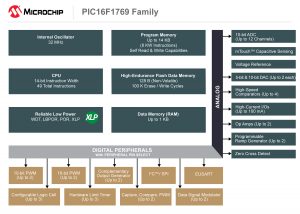Microchip Announces MCU Family Providing Multiple Independent, Closed Loop Power Channels and System Management
Microchip Technology Inc., a leading provider of microcontroller, mixed-signal, analog and Flash-IP solutions, today announced from the Embedded World conference in Germany a new family of 8-bit PIC® Microcontrollers (MCUs) with the PIC16(L)F1769 family. This family is the first PIC MCU to offer up to two independent closed loop channels. This is achieved with the addition of the Programmable Ramp Generator (PRG), which automates slope and ramp compensation, increases stability and efficiencies in hybrid power conversion applications. The PRG provides real-time, down to the nanosecond, responses to a system change, without CPU interaction for multiple independent power channels. This allows customers the ability to reduce latency and component counts while improving system efficiency.
Watch a short video: http://www.microchip.com/PIC16L_F1769-Product-Video-022415a
View a brief presentation: http://www.microchip.com/PIC16L_F1769-Press-Presentation-022415a
 The PIC16(L)F1769 family includes intelligent analog and digital peripherals, including tri-state op amps, 10-bit Analog-to-Digital Converters (ADCs), 5- & 10-bit Digital-to-Analog Converters (DACs), 10- and 16-bit PWMs, and high-speed comparators, along with two 100 mA high current I/Os. The combination of these integrated peripherals help support the demands of multiple independent closed-loop power channels and system management, while providing an 8-bit platform that simplifies design, enables higher efficiency and increase performance while helping eliminate many discrete components in power-conversion systems.
The PIC16(L)F1769 family includes intelligent analog and digital peripherals, including tri-state op amps, 10-bit Analog-to-Digital Converters (ADCs), 5- & 10-bit Digital-to-Analog Converters (DACs), 10- and 16-bit PWMs, and high-speed comparators, along with two 100 mA high current I/Os. The combination of these integrated peripherals help support the demands of multiple independent closed-loop power channels and system management, while providing an 8-bit platform that simplifies design, enables higher efficiency and increase performance while helping eliminate many discrete components in power-conversion systems.
In addition to power-conversion peripherals, these PIC MCUs have a unique hardware-based LED dimming control function enabled by the interconnections of the Data Signal Modulator (DSM), op amp and 16-bit PWM. The combination of these peripherals creates a LED-dimming engine synchronizing switching control eliminating LED current overshoot and decay. The synchronization of the output switching helps smooth dimming, minimizes color shifting, increases LED life and reduces heat. This family also includes Core Independent Peripherals (CIPs) such as the Configurable Logic Cell (CLC), Complementary Output Generator (COG) and Zero Cross Detect (ZCD). These CIPs take 8-bit PIC MCU performance to a new level, as they are designed to handle tasks with no code or supervision from the CPU to maintain operation, after initial configuration. As a result, they simplify the implementation of complex control systems and give designers the flexibility to innovate. The CLC peripheral allows designers to create custom logic and interconnections specific to their  application, reducing interrupt latency, saving code space and adding functionality. The COG peripheral is a powerful waveform generator that can generate complementary waveforms with fine control of key parameters, such as phase, dead-band, blanking, emergency shut-down states and error-recovery strategies. It provides a cost-effective solution, saving both board space and component cost. The ZCD senses when high voltage AC signal crosses through ground, ideal for TRIAC control functions.
application, reducing interrupt latency, saving code space and adding functionality. The COG peripheral is a powerful waveform generator that can generate complementary waveforms with fine control of key parameters, such as phase, dead-band, blanking, emergency shut-down states and error-recovery strategies. It provides a cost-effective solution, saving both board space and component cost. The ZCD senses when high voltage AC signal crosses through ground, ideal for TRIAC control functions.
These new 8-bit PIC MCUs provide the capability for multiple independent, closed loop power channels and system management making these products appealing to various power supply, battery management, LED lighting, exterior/interior automotive lighting and general-purpose applications. Along with all these features, the family offers EUSART, I2C™/ SPI and eXtreme Low Power (XLP) Technology, which are all offered in small form-factor packages, ranging from 14- to 20-pin packages.
“The real power of the PIC16F1769 family is the ability to interconnect these on-chip peripherals to create custom functions specific to your application,” said Steve Drehobl, vice president of Microchip’s MCU8 Division. “This paired with the ability to simultaneously control independent closed loop channels brings a level of capability not traditionally found on low cost 8-bit PIC MCUs.”
